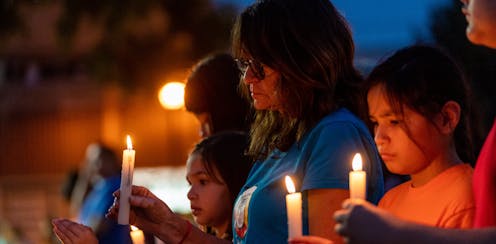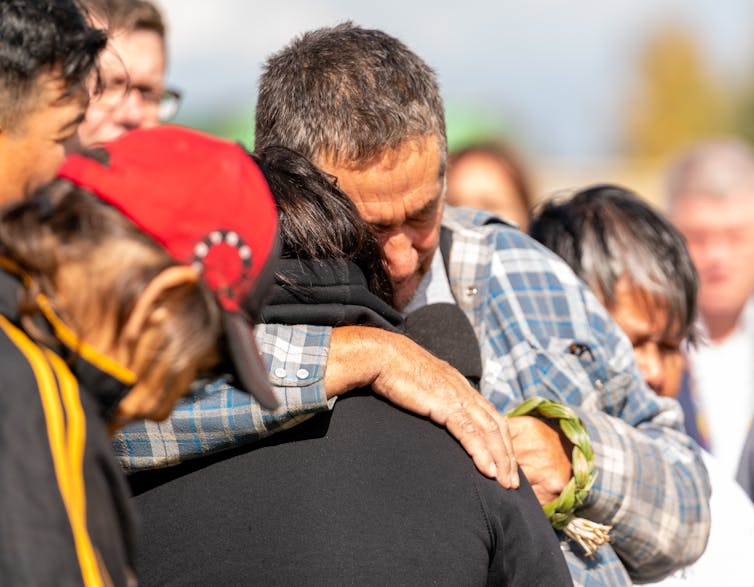
The recent mass killings at James Smith Cree Nation have left many trying to understand what could have led to such a horrific loss of life. As things stand, it is unclear that there was any one motivator behind the violence that claimed 11 lives and wounded 18 others.
As scholars of settler colonialism in Saskatchewan (Métis, and non-Indigenous), we have some thoughts about what led to these terrifying events and unimaginable pain that this small community is left to grieve through.
Much attention has been placed on the causes of the men’s actions and histories, as well as the victims. However, the story goes much further than any of these individual lives. Ending the story here implies that the problem rests within Indigenous communities. Focusing on decisions made within the criminal justice system implies that this horrific event could have been avoided if a single person had been kept in jail.
Yet the three communities that make up James Smith Cree Nation deal with much wider realities. Members of the bands attended residential schools all around the area, from Prince Albert Indian Residential School to Gordon’s Indian Residential School or St. Barnabas Residential School in Onion Lake.
Read more: Saskatchewan stabbings: Why Myles Sanderson was granted statutory release from prison
In 2018-19, the nation fought a mining development that threatened the land and ceremonial grounds. Chief Okimaw Wally Burns of the James Smith Cree Nation band explained, “the way things stand, everyone else gets the benefits of a mine, while we are left with all the consequences.”
Leaders from the community therefore attempted to balance environmental and cultural concerns with economic benefits for the communities. Looking to innovate and offer opportunities within their community and to their neighbours, they successfully launched an MRI company through a partnership with the University of Saskatchewan.
And in 2020, the three communities tried to develop their own response to the pandemic, only to be frustrated by government agencies standing in their way and asserting control at the cost of the well-being of the community.

All these stories are related. Residential schooling, the dangers of resource extraction, the challenges of economic development and government control and paternalism are all part of one system: settler colonialism.
Read more: Logging company clears Cree Nation ancestral trail without recourse
The violence of settler colonialism
Contemporary Saskatchewan is deeply shaped by early settler colonial tactics. The formation of settler communities through road, rail and economic practices is directly linked to the oppression of Indigenous Peoples. There is deeply rooted racism in the political culture of the province. The ongoing settler colonial violence in Saskatchewan, specifically gender-based violence, is directly rooted in this history of settlement.
Settler colonialism is characterized by the marginalization and genocide of Indigenous Peoples who are forcefully supplanted by settlers. The state takes the land from Indigenous nations who had until then thrived and governed themselves, and gives it to those who come to settle and occupy the land. These practices foster the erasure of Indigenous society and are inherently violent.
In Canada, we can see the violence of this erasure in a few key moments in the settlement of the nation. For example, clauses concerning the surrender of Indigenous land were added to treaties after negotiations had concluded. Indigenous peoples were then physically marginalized through the reserve system or road allowance communities, as the government regulated with the intent to eradicate Indigenous languages and cultures through policy, legislation and residential schools, often at the behest of churches.

Settler colonial violence in Canada might not be obvious. For example, Canada’s reputation as a peaceful nation is built through myth-making based on perceptions of benevolence and saviourism towards Indigenous Peoples and racially marginalized newcomers.
This national myth positions Indigenous cultures as uncivilized and in need of saving through settler colonial benevolence. Above all, Indigenous people are seen as needing to be saved from themselves, whether it’s their own actions, those of their community members or from their cultures.
A first step away from colonialism
Violent settler colonialism and deep-seated racism have created the conditions for substandard health, education and social services in Indigenous communities.
These conditions keep Indigenous people in a state where they cannot effectively challenge settler colonialism. They are tethered to the settler colonial project that keeps Indigenous Peoples marginalized socially, physically and economically.
If the root of the problem is the attempt to eliminate people and destroy their capacity to make decisions for themselves, then the solution begins with agency. The principle of self-determination at the heart of the United Nations Declaration on the Rights of Indigenous Peoples has not yet had an impact on policy in Canada.
Against the enormity of this system, there is only one solution: to listen to the community.
James Smith Cree Nation has been clear about the issue of substance use and the need for direct action through the form of on-reserve addictions supports. It has also asked for better response time from police and, above all, control over its own policing.
Those who are most affected by such far-reaching problems are the best placed to provide the solutions.
The authors do not work for, consult, own shares in or receive funding from any company or organisation that would benefit from this article, and have disclosed no relevant affiliations beyond their academic appointment.
This article was originally published on The Conversation. Read the original article.







